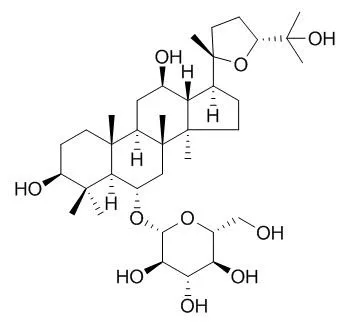RP-HPLC-ELSD was adopted. The analysis was performed on a Dimaonsil C18 (250 mm x 4.6 mm, 5 μm) column, the mobile phase was acetonitrile (A)-deionized water (B) in gradient elution mode.
METHODS AND RESULTS:
The flow rate was 1.0 mL/min and column temperature was set at 30 °C. The carrier gas was nitrogen with flow rate of 2.8 L/min, the drift tube temperature was 100 °C, and the injection volume was 10 μL. The principle component analysis and cluster analysis of SPSS software (version 19.0) were conducted for the data analysis. The RP-HPLC-ELSD method for determining simultaneously nine ginsenosides and two pseudoginsenosides was established. The total content of ginsenosides of one- to two-year-old was low and increased from May to September in each year. That of three- to five-year-old declined from June to July and increased from August, and was the highest in September of three- to five-year-old samples. The total content from September of three-year-old samples was similar. The content of nine ginsenosides and two pseudo-ginsenosides was relatively high in all the samples except ginsenoside Rc, which wasn't determined in some samples. The ginsenosides Rd, Rb3 and pseudo-ginsenoside F11 were higher than others. The principle component analysis results showed that ginsenosides Rg1, Re, Rb1, Rc, Rb2, Rb3, Rg3 and pseudoginsenoside F11,Pseudoginsenoside RT5 could be the characteristic ginsenosides of Panax quinquefolium root in Canada.
CONCLUSIONS:
The cluster analysis indicated that the chemical constituent and dynamic accumulation of ginsenosides of one- to two-year-old was similar except the sample of July of four-year-old and there was no obvious difference of three- to five-year-old. |






 Cell. 2018 Jan 11;172(1-2):249-261.e12. doi: 10.1016/j.cell.2017.12.019.IF=36.216(2019)
Cell. 2018 Jan 11;172(1-2):249-261.e12. doi: 10.1016/j.cell.2017.12.019.IF=36.216(2019) Cell Metab. 2020 Mar 3;31(3):534-548.e5. doi: 10.1016/j.cmet.2020.01.002.IF=22.415(2019)
Cell Metab. 2020 Mar 3;31(3):534-548.e5. doi: 10.1016/j.cmet.2020.01.002.IF=22.415(2019) Mol Cell. 2017 Nov 16;68(4):673-685.e6. doi: 10.1016/j.molcel.2017.10.022.IF=14.548(2019)
Mol Cell. 2017 Nov 16;68(4):673-685.e6. doi: 10.1016/j.molcel.2017.10.022.IF=14.548(2019)